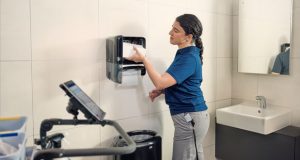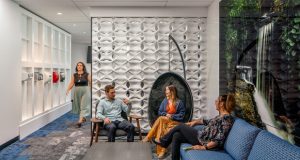Returning to work following the festive period can often go one of two ways. Your employees either come back feeling refreshed, recharged and focused on the year ahead, or with the shorter days and memories of the recent festive break, they may lack motivation. And, with the cold January weather amplifying the risk of bacteria and illnesses spreading, cleaners and building managers can’t afford to let any post-holiday lack of motivation lead to hygiene levels slipping. In this piece, Paul Casson, Technical Field Manager at Rentokil Specialist Hygiene & Jamie Woodhall, UK Technical & Innovation Manager, Initial Washroom Hygiene explore how to avoid a new year’s hangover, and set the foundations to make your premises a hygiene haven for the year ahead.
Establish the process
Priority number one is to ensure there is a regular cleaning regime in place. This starts with identifying key areas that need frequent attention and those that can receive less regular cleaning. With most bacteria and viruses transmissible through touch, shared contact points – such as door handles, surface tops and communal areas – will need constant attention, while other areas may require less frequent cleaning. After conducting this audit, it is important to establish and formalise a cleaning plan. Displaying and maintaining cleaning logs throughout the premises provides a visual progress report that helps to ensure the plan is followed on an ongoing basis.
Schedule a regular deep clean
On top of a regular cleaning regime, it’s important that a thorough deep clean takes place at least twice a year, ideally by a professional cleaning company. We recommend scheduling these to avoid peak periods. Ideally, one of the deep cleans should take place prior to the onset of winter to ensure your premises is as hygienic as possible at a time when the risk of bacteria and illness spreading is generally at its highest. Winter is often when flu and norovirus outbreaks occur and is when people tend to spend more time indoors, so cross contamination risks are higher.
Professional cleaners will have access to specialist multi-purpose biocidal cleaners, which can decontaminate surfaces by killing bacteria, fungi, spores, yeasts and viruses. The deep clean should include a thorough disinfection of high frequency touch points, as well as moving all furniture or equipment away from the walls to make sure no areas are being missed from the cleaning routine. One powerful tool in the deep cleaning arsenal is Ultra Low Volume (ULV) disinfectant fogging. This method is carried out by a specialist and enables the treatment of large areas in a short space of time. It works by generating a mist of disinfectant, which settles on top of, underneath and on the sides of objects, soft furnishings, furniture and hard-to-reach areas, offering maximum surface area coverage.
High Level Cleaning
Many facilities will have areas that are difficult to keep clean and hygienic, often because they are hard to reach. In these cases, cleaning them can represent a safety risk. Specialist hygiene professionals have both the equipment and expertise to clean ceilings, lights, ducts and other hard to reach spaces. Technicians work to stringent health and safety standards and complete a thorough risk assessment before undertaking any cleaning operation.
Mobile lifts and cherry pickers can allow technicians to reach elevated areas, and mobile scaffold towers provide a free standing, stable and easily movable working platform. Technicians can even make use of rope access to abseil down to certain parts of a facility when required. Once onsite, specialist cleaning technicians will also have tools which can be used to clean these difficult places, such as jet washers, backpack vacuums, water feed brushes and long reach poles. These specialist cleaning activities can be incorporated as part of the facility’s deep cleaning strategy.
Encourage good hand hygiene amongst employees
While cleaning plays a vital role in creating a hygienic premises, ensuring occupants play their part can be equally important. Hands are a natural breeding ground for germs and one of the principle carriers of harmful pathogens – in fact nearly 80% of infections are spread by hand. Regular handwashing plays a vital role in reducing the transfer of pathogens and harmful bacteria throughout the office, so it’s imperative employees wash their hands after using the washroom, but also regularly throughout the day.
Think about how many hands come into contact with shared touch points in communal areas such as an office kitchen. Research from Initial Washroom Hygiene has found that something as simple as making a colleague a cup of tea can become a potential contamination issue. A swabbing experiment looking at various touchpoints in the office kitchen found that the level of microbial activity on the caddies where office tea bags were often kept was on average 17 times higher than a toilet seat.
The important first step in a proper hand hygiene strategy is to ensure that users of the premises have access to the essential hand washing tools – warm water, soap, drying facilities and ideally, hand sanitiser. There should be ample of these products in the washroom, kitchen and throughout the building. Secondly, placing hand washing reminders around the sink area and throughout the office; and explaining how regularly washing hands will help boost the overall hygiene levels in the office, will hopefully encourage best practice.
Final Words
Cleaning is an incredibly important part of keeping facilities safe and operational for both visitors and staff. A regular cleaning regime helps to keep areas presentable and to prevent outbreaks of illness. However, it’s also important that all cleaning professionals know the limits of routine cleaning, and when a specialist treatment is required. With the right planning, processes and partners in place, every facility can become a hygiene haven.
By:


Paul Casson, Technical Field Manager at Rentokil Specialist Hygiene
& Jamie Woodhall, UK Technical & Innovation Manager, Initial Washroom Hygiene





